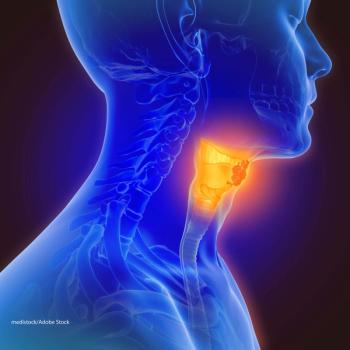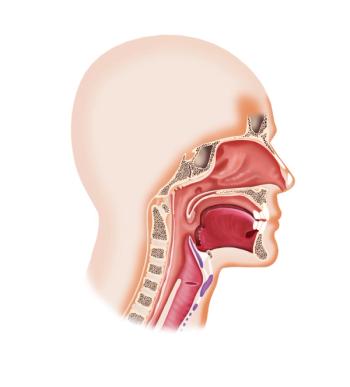
Oncology NEWS International
- Oncology NEWS International Vol 9 No 1
- Volume 9
- Issue 1
RT Fractionation Improves H&N Cancer Control
SAN ANTONIO-Local-regional control significantly improved with two radiotherapy fractionation variants delivering either increased total dose or shorter treatment time, compared with standard fractionation, in patients with locally advanced squamous cell carcinoma of the head and neck, Karen Fu, MD, reported at the 41st Annual Scientific Meeting of the American Society for Therapeutic Radiology and Oncology (ASTRO).
SAN ANTONIOLocal-regional control significantly improved with two radiotherapy fractionation variants delivering either increased total dose or shorter treatment time, compared with standard fractionation, in patients with locally advanced squamous cell carcinoma of the head and neck, Karen Fu, MD, reported at the 41st Annual Scientific Meeting of the American Society for Therapeutic Radiology and Oncology (ASTRO).
Fractionation schedule is probably one of the most important factors determining the outcome of radiation therapy, said Dr. Fu, professor of radiation oncology, University of California, San Francisco. The optimal fractionation schedule has been controversial.
In this phase III Radiation Therapy Oncology Group trial (RTOG 9003), patients received radiotherapy delivered using standard fractionation, hyper-fractionation, accelerated fractionation with split course, or accelerated fractionation with concomitant boost (see Table).
The total dose with hyperfrac-tionation is 16.6% higher while the overall treatment time is the same as that of standard fractionation, Dr. Fu said. The overall treatment time for the two accelerated fractionation schedules is 1 week shorter, although the total radiation doses are similar to those with the standard fractionation regimen.
More Than 1,000 Patients
The study was opened in September 1991 and closed in August 1997. The number of patients entered was 1,113. Of these, 1,073 patients were analyzable and formed the basis of this report, Dr. Fu said. The most common primary site was the oropharynx, accounting for 60% of the patients, followed by supraglottic larynx, hypopharynx, and oral cavity.
The primary disease was stage T1 in 6% of patients, T2 in 27%, T3 in 38%, and T4 in 29%. Thus, two thirds of the patients had a T3 or T4 lesion, she said. The node stage was N0 in 22% of patients, N1 in 20%, N2 in 46%, and N3 in 12%. By overall stage, 4% of the patients had stage II disease (base of tongue or hypopharyngeal primaries only); 28% had stage III disease; and 68% had stage IV disease. The median follow-up was 23 months for all analyzable patients.
Study Results
The 2-year local-regional control rate was 54.5% for accelerated fractionation with concomitant boost and 54.4% for hyperfractionation, significantly better than the 46% rate for standard fractionation. Accelerated fractionation with split course produced a local control rate of 47.5%, which was not significantly different from standard fractionation.
The 2-year disease-free survival was 37.6% for hyperfractionation and 39.3% for accelerated fractionation with concomitant boost, compared with 31.7% for standard fractionation. For accelerated fractionation with split course, it was 33.2%, which was not significantly different from standard fractionation.
The 2-year overall survival was 54.5% for hyperfractionation, 46.1% for standard fractionation, 50.9% for accelerated fractionation with concomitant boost, and 46.2% for accelerated fractionation with split course.
There was a trend toward improved disease-free survival for hyperfraction-ation and accelerated fractionation with concomitant boost. However, there was no significant difference in overall survival, Dr. Fu said. As expected, acute toxicity increased with hyperfractionation and accelerated fractionation, but was tolerable, she added. Late toxicity was mostly transient, and there was no significant difference in the incidence of persistent late toxicity among the treatment arms.
The 2-year distant metastasis rate ranged from 16.6% to 18%, and there was no significant difference among the treatment arms, Dr. Fu reported.
This was one of the largest randomized controlled trials of the treatment of head and neck cancer mounted in the United States in the past 20 years, Dr. Fu said. As such, it has great validity.
Based on the results of this trial, future RTOG phase III trials for locally advanced head and neck cancer will use accelerated fractionation with concomitant boost as the control arm.
Articles in this issue
almost 26 years ago
New Strategies for Treating Ovarian Canceralmost 26 years ago
Researchers See More Effective Lung Cancer Screening, Therapyalmost 26 years ago
Goserelin Reduces Breast Ca Recurrence in Younger Womenalmost 26 years ago
ODAC Recommends Approval of Targretin for Advanced CTCLalmost 26 years ago
IOM Assessing Early Breast Cancer Detection Technologiesalmost 26 years ago
CRFA Honors Three With Its 1999 FrontLine Awardsalmost 26 years ago
Aromasin, New Hormonal Agent, Approved for Breast Canceralmost 26 years ago
LEDs Developed by NASA Used to Ablate Brain Tumorsalmost 26 years ago
Early Androgen Deprivation Beneficialalmost 26 years ago
Higher-Dose RT May Improve Prostate Cancer OutcomeNewsletter
Stay up to date on recent advances in the multidisciplinary approach to cancer.





